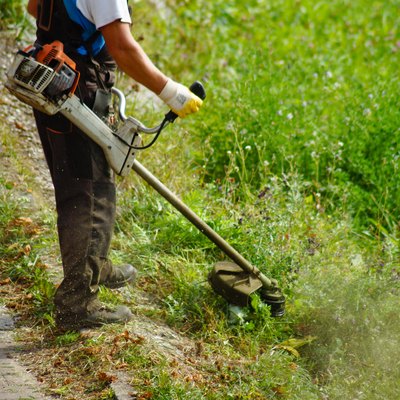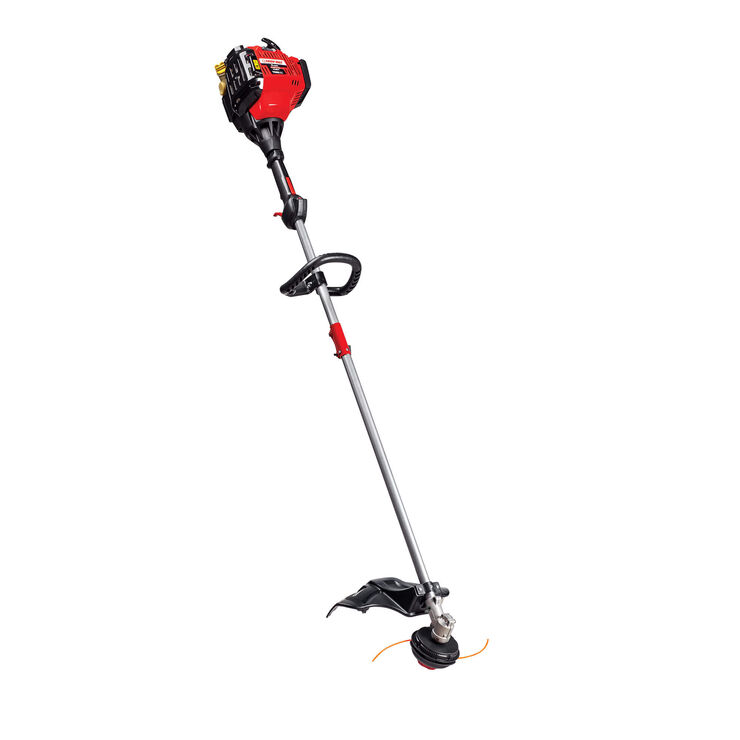That ratio translates to 2.6 fluid ounces of oil for every gallon of gasoline; if you're mixing 5 gallons of gas, you would add 12.8 ounces of oil. You seldom have to measure out the oil - most two-cycle oil comes in calibrated containers, and you can determine the amount you're using by reading the scale on the side. What oil gasoline ratio does a Toro weed eater require? The ratio is 40:1 which come to 3.2oz of oil per gallon of gasoline. What is fuel oil ratio for a 3hp 2 stroke Toro snowblower? Video demonstrates the correct oil and gas mix for 2 cycle engine yard tools. In order to extend the life of these lawn tools and k.
Amazon has put together some great Home Holiday Guide Deals - save money and get your holiday shopping done! Click Here to see the latest deals (link To Amazon)
Gas weed eaters offer lots of power – unless they won’t start, that is. It can be so frustrating when a string trimmer won’t crank and the truth is, there could be a lot of reasons why. But there are a few simple checks that you should make before taking it to a professional or tossing it in the trash.

All STIHL gasoline-powered equipment runs on a 50:1 mixture of gasoline and 2-cycle engine oil. Knowing the proper way to mix your fuel is the first step in keeping it running strong and long. How to Mix Gas for a Weed Wacker. Weed wackers are a handy tool for all homeowners to have, so naturally you want to keep yours in good working order. Like other small-engine power tools, weed wackers require a mixture of engine oil.
If your gas weed eater is not starting, the most common causes are:
- Fuel-related issues
- Malfunctioning spark plug
- Dirty carburetor
- Air filter blockage
- Recoil starter
- Flooded engine
Depending on what is preventing your weed eater from working correctly, troubleshooting is a fairly simple process.
Let’s have a look at how to identify, isolate, and solve the issue so that you can get back to work on your lawn.

Gas Weed Eater’s Common Issues And Solutions
Often after being stored over winter or just by luck of the draw, a gas-powered weed eater will need a little maintenance to work correctly again. But when you get right down to it, they have a simple two-stroke engine that you can troubleshoot with basic tools and a little DIY knowledge.
Fuel Related Issues
Fuel related issues are the most common problems you will need to solve over the life of your weed eater. Here are a few of the more common fuel issues that may be causing a problem:
- The fuel is running low
- The tank is full, but with old fuel. Oxygen and moisture can damage the fuel over time.
- The gasoline and oil have separated, preventing the engine from getting enough fuel.
Troubleshooting Fuel Related Issues
To solve fuel-related problems, proceed with these steps:
- First, check the level of fuel in the tank. If it is empty or low, the weed eater will not start.
- If there is enough fuel and it is fresh, lightly shake and swirl the weed eater to ensure that oil and gasoline are not separated.
- If you are using the weed eater for the first time after several months, you should swap the old fuel for a new mixture. Many string trimmers require a 40:1 or 50:1 gas-to-oil ratio. (Check your owner’s manual for your model’s requirement).
- It is extremely important that you use gasoline with only 10% alcohol or an ethanol-free variety and oil designed for 2-cycle engines. This allows for the piston and crankshaft to stay lubricated.
Learn why ethanol can cause significant damage to gas-powered outdoor yard tools.
Spark Plug Issues
If you have tried to turn the engine on and it is not giving you any sign of life, the problem might lie in the spark plug.
A fouled spark plug won’t be able to deliver electric current from the ignition system, which is necessary to ignite the fuel in the combustion chamber of your weed eater. In this case, the possible issues are:

- A dirty spark plug
- A cracked or faulty spark plug
Troubleshooting Spark Plug Related Issues
If the problem involves a dirty spark plug, you can quickly solve it by cleaning it with a spray-on plug cleaner (source).
Toro Weed Wacker Gas Oil Ratio
To remove any extra debris, proceed by scraping the spark plug with a knife. For the best maintenance, you should clean the spark plug every season and after prolonged use (around 25 hours).
If the spark plug is cracked or faulty, you will need to replace it altogether. These are inexpensive and easy to buy in your local DIY store. To check for a damaged spark plug, you should:
Oil For Weed Wacker
- Disconnect the lead and clean the surrounding area
- Remove it using a spark plug socket
- Check the porcelain for cracks and scratches
Assuming it isn’t cracked, it probably just needs a good cleaning. Once cleaned, replace the spark plug, ensuring that it is not too tight and try to restart the engine.
Carburetor Issues
The carburetor is the heart of the engine. It is responsible for controlling the engine’s speed and the ratio between fuel and air.
If your carburetor is amiss, dirty, or cracked, your weed eater won’t work. Some common telltale signs of a fault carburetor are:
- Black smoke
- Backfiring
- It is hard to start or bogs down and dies when the engine is throttled
Troubleshooting Carburetor Related Issues
The first thing we want to do is to clean the carburetor. It’s a fairly easy task and doesn’t require a lot of tools.
Depending on your weed eater model, start by removing the filter cover and the filter. Then proceed by unscrewing the screws that hold the primer bubble in place. Once you have opened your carburetor, you can clean it thoroughly and unclog the filter.
You may be able to clean the carburetor without needing fresh gaskets but as a rule, it’s best to have an inexpensive rebuild kit like this one (link to Amazon) handy. If this one doesn’t match your weed eater’s engine, just search for your brand.

This YouTube video from eReplacement Parts walks you through the process of cleaning the carburetor and has a lot of handy tips.
Carburetors are one of the more common fuel-related issues for 2-stroke engines. Someday, someone is going to invent a better version that isn’t prone to clogging. In the meantime, though, do yourself a favor and use quality fuel.
Air Filter Issues
The air filter is another essential part of a 2-stroke engine. It allows fresh air (oxygen) to enter the combustion chamber. This is necessary for the ignition process to begin.
At the same time, air filters ensure that no external and potentially damaging debris enters the engine while delivering a clean flow of oxygen.
The air filter can become blocked or dirty after prolonged use or if you have stored your weed eater for too long. A common sign that the main issue with your string trimmer lies in the air filter is the engine starting and then stopping abruptly after a couple of minutes.
Troubleshooting Air Filter Related Issues
Air filter problems can be solved quickly by cleaning or replacing the filter.
- Start by removing the screws that hold the air filter in place, usually near the rear of the engine.
- Clean the air filter with warm water and dish soap
- Once cleaned, you can soak the filter in lukewarm water
- Rinse and squeeze it various times to get out all the remaining water and soap in the pores.
- Let the filter air-dry and place it back only once it is fully dry.
It’s often better to just replace these. They are very inexpensive.
Flooded Engine Issues
If you tried to fix any of these issues without knowing how to do it, the chances are that you kept trying to restart the engine. As a result, you now have a weed eater that won’t start and has a flooded engine.
Similar to an older car, the engine of your weed eater can be “flooded” with a too-rich blend of fuel and air.
Troubleshooting Issues
Thanks to its simple engine, it is easy to unflood a weed eater. Usually, all you will need to do is:
- Ensure that the on/off switch is on the “on” position
- Position the choke “off”.
- While holding the throttle trigger, pull the starter recoil several times quickly. This may take a lot of pulls.
- Keep holding the trigger while black smoke leaves the weed eater.
- Release the trigger
If you are having trouble visualizing this, here is a great YouTube video from Steve’s Small Engine Saloon where he intentionally floods the weed eater then goes through the simple process of unflooding it.
This process of repeatedly pulling on the starter recoil while holding the throttle down allows the weed eater to get rid of any extra fuel that has filled the combustion chamber. It’s common to see black smoke resulting from the engine. That’s the weed eater burning off the excess fuel.
When To Bring Your Weed Eater To A Repair Shop
Recoil starters can be a little tricky to replace if you don’t have any experience with small engine repair. If the recoil spring has snapped, it will be impossible for you to start the weed eater altogether.
In this case, I’d recommend just bringing it in for a professional servicing. While you can repair it at home in about 20 minutes, it’s not something I’d recommend doing unless you know your way around an engine.
Tips For Keeping Your Weed Eater Running
Once you have it running again, there are a few best practices that you should implement to make sure your weed eater running at top performance:
- Use fresh, ethanol-free fuel. I highly recommend buying a premix. It costs more upfront but you never have to worry about improper gas-to-oil ratio mixtures or accidentally using two-stroke oil that has gone bad.
- Replace the spark plug and air filter at the beginning of every season. It’s super-inexpensive and will keep your engine running trouble-free.
The majority of issues that you’ll encounter with a 2-stroke yard tool’s engine can be avoided with just a little preventative maintenance and good choices, especially when it comes to the quality of fuel that you use.
Conclusion
If your gas weed eater won’t start, these are the most common causes and troubleshooting steps that should be taken. With just a little maintenance and TLC, a weed eater can keep running season after season.
To solve most issues that can result in a malfunctioning weed eater, you only need a few tools and little DIY knowledge. Yet, if you have already checked the spark plug, air filter, carburetor, fuel tank, and unflooded the engine without a result, a quick visit to your repair shop may be needed.
In the market for a new weed eater? Read my head-to-head comparison between Stihl and ECHO, two of the largest manufacturers out there.
And if you are just sick and tired of your gas-powered yard tools needing repair and maintenance, be sure to read Gas vs Electric: 6 Reasons To Use Battery-Powered Yard Tools.
Recommended Gas Trimmer:
- Echo GT-225 2 Cycle 21.2cc Curved Shaft Gas Trimmer (Link to Amazon)
Recommended Electric Trimmer:

- Ego 56-Volt Lith-ion Cordless Electric 15 in. String Trimmer (Link to Amazon)